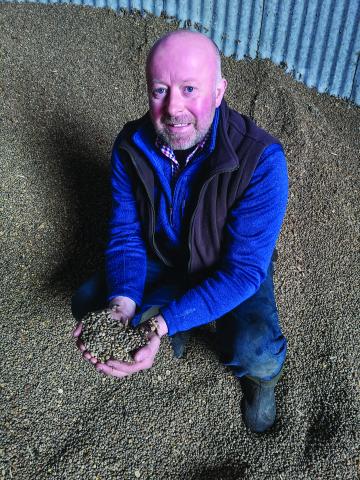When Durham farmer, Rob Crowe, started his search for a new mill for rolling cereals, he could not have imagined it would be the prompt for a whole new cropping rotation which would cut out bought-in protein from his livestock feeds.
But this is essentially what happened at Bishops Close Farm in Spennymoor, near Durham City, where Mr Crowe and his family farm 450 acres (182ha) of beef, sheep and arable and have replaced almost 10 tonnes per annum of bought-in soya with home grown peas, beans and lupins.
The process began when his search for a feed mill took him to the Royal Highland Show in 2016 where he purchased a Murska 350 from Kelvin Cave Ltd.
“I bought the mill to roll barley, but I had a conversation with Michael Carpenter [Kelvin Cave’s northern area manager] about growing our own protein and being self-sufficient in feed,” says Mr Crowe.
“I had grown peas and beans before but had sold them commercially, dried to 14% moisture,” he says. “But Michael suggested we could grow peas, beans and lupins to harvest early, at around 22% moisture, roll them through the mill, preserve them using Propcorn NC and feed them to our sheep and beef.”
Mr Carpenter explains: “The Murska 350 has tempered-hardened steel, fluted rollers which are capable of gripping and rolling large seeds such as pulses. By fitting the mill with an applicator and treating with the non-corrosive [NC] form of Propcorn in the same process, Rob could eliminate his drying costs and safely store his peas, beans or lupins in a pile in ashed. And, because harvest would be 3-6 weeks earlier, he could also get a head start on autumn cultivations.”
A further benefit of the pulses was that they could satisfy the farm’s compliance with the Basic Payment Scheme’s greening rules as an EFA [Ecological Focus Area].
“But this meant I couldn’t use any sprays on the crop so Michael suggested we grew the peas and beans together as they’d be more successful without any herbicide if they were a mixed crop,” he says.
Roger Vickers, chief executive of PGRO (Processors and Growers Research Organisation) explains: “The two crops complement each other well since the peas help provide earlier ground cover than the
beans, which helps to smother weeds, while the beans provide a strong scaffold which helps keep the peas standing later in the season.
“Trials indicate that mixed crops regularly produce more than the crops grown individually, and because the beans support the peas, the whole crop should remain standing for harvest.”
In fact, Mr Crowe said he would have expected a yield of 1.4-1.5 tonnes/acre (3.5-3.7t/ha) from
either of the single crops when grown without chemical inputs, but in practice, this increased to
around 2t/acre (5t/ha) when the crops were grown together.
Whilst the yield was potentially bolstered by the complementary growth habits of the two crops, the earlier harvest would have also typically given slightly higher yields.
Mr Carpenter explains: “When harvest is taken earlier, there’s not just higher freshweight yields but also higher dry matter/ha. This is because the crop is taken in optimum condition before seed losses from birds and pod shatter.”
“A local beekeeper also put two or three hives in each field and that helps greatly with pollination,” adds Mr Crowe. “I’m convinced that by doing this we have more pods furtherdown the plant.
“There’s also no need for desiccation with the higher moisture harvest, so this keeps the crop
within the EFA compliance and saves another process and cost,” he adds. “And of course, first wheats also tend to be higher yielding aftera legume than other break crops.”
Once the crop was harvested (last year on 1 October), Mr Crowe rolled it through his mill and
applied the Propcorn NC in the same process.
He says: “The beans came in at a higher moisture than the peas but both seeds rolled well through the mill. The beans rolled into a nice flake but the peas were more shattered, so with the benefit of experience, I may have harvested the crop a week or so earlier andaimed for their moisture at closer to 25%.”
Mr Crowe used the mix in rations for all types of livestock, from his 400 in-lamb ewes and their
growing and finishing lambs to the 60 head of beef which he sells at 13-16 months, either as
stores or fat.
He also uses the 10 acres of lupins he grows as a single crop, harvesting these separately but
on the same day as the peas and beans, also rolling and preserving with Propcorn NC.
Rations vary for different types of stock but a one tonne mix for the ewes comprises 200kg whole oats, 50kg rolled lupins, 150kg rolled bean/pea mix, 20 litres of molasses and the remainder rolled barley.
With lupins analysing at over 30% crude protein and peas and beans in the mid to high 20%s, he says the mix can readily supply sufficient protein. Although more of the protein in the home-grown crops is rumen degradable compared with the soya, the lupins have a morefavourable amino acid profile than peas or beans and help lift the level of digestible undegradable protein (DUP).
“I can’t say the stock do better than on soya, but they certainly do just as well,” says Mr Crowe. “But more important, we like the mix we’re feeding and know exactly what’s in it and we like the security of having enough in storage to keep us going through the year.”
The upshot is that a feed bill for two tonnes of soya every month at around £360/t has been replaced by the growing costs for pulses. These have been calculated at £123-£168/t (see panel), with zero food miles, improved food security and, unlike soya, no risk of habitat destruction across the Americas and no genetic modification.
“I appreciate the system might not be for every farmer, but for our mixed farm it seems to work
really well,” says Mr Crowe. “It’s important tome in the current climate that we aim to be self-sufficient and this is helping us achieve that goal. We actually ran out of our home-grown pulses last August and had to buy in just 1.5 tonnes of soya. But now we have taken on extra land, we plan to grow more pulses in the years ahead which will hopefully mean there’s little need for bought-in feed at all.”
Growing a mixed crop of peas and beans at Bishops Close Farm
● Ploughed up wheat stubbles over winter ready for 15 acres of peas/beans.
● Drilled peas and beans on 1 April 2019 using combination drill.
● Power harrowed in front of drill and harrowed behind to give fine tilth.
● Combine harvested pea/bean mix at 22% moisture on 1 October 2019.
● Also combined adjoining field of lupins on same day at 25% moisture.
● Processed through Murska 350 fitted with Propcorn applicator.
● Rolled and treated with Propcorn NC within two days of harvest.
● Stored in shed for up to a year until fed to sheep and beef.
● Earlier and wider harvest window eased farm’s workload.
● Extra time for autumn cultivations and improved first wheat after legumes.
See the original issue of Kelvin Cave's KnowHow Newsletter Below.



